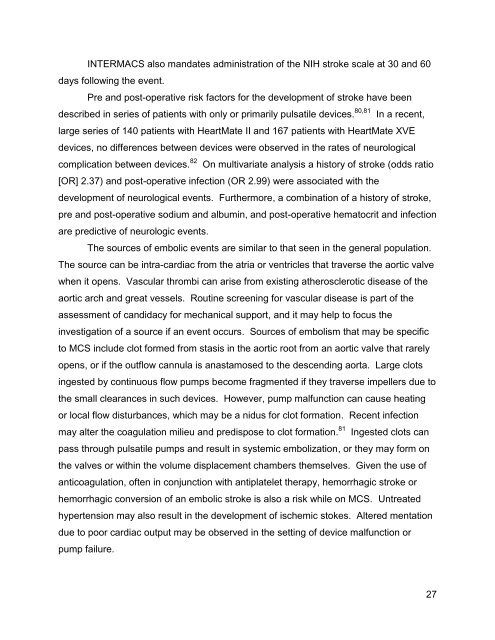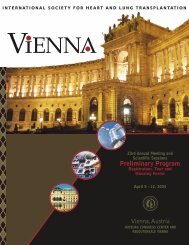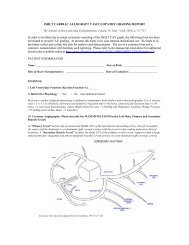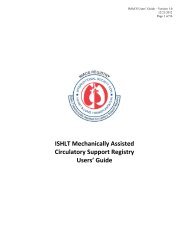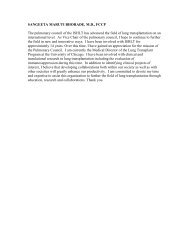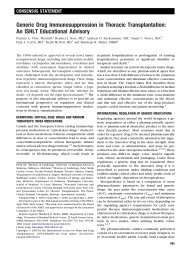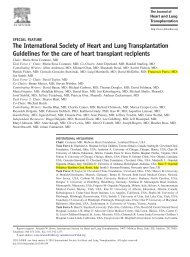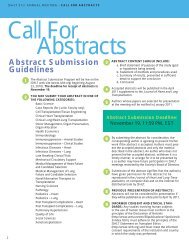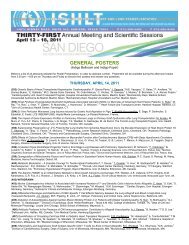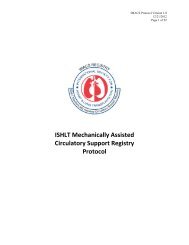Task Force 4: Inpatient Management of Patients with MCSD - The ...
Task Force 4: Inpatient Management of Patients with MCSD - The ...
Task Force 4: Inpatient Management of Patients with MCSD - The ...
Create successful ePaper yourself
Turn your PDF publications into a flip-book with our unique Google optimized e-Paper software.
INTERMACS also mandates administration <strong>of</strong> the NIH stroke scale at 30 and 60<br />
days following the event.<br />
Pre and post-operative risk factors for the development <strong>of</strong> stroke have been<br />
described in series <strong>of</strong> patients <strong>with</strong> only or primarily pulsatile devices. 80,81 In a recent,<br />
large series <strong>of</strong> 140 patients <strong>with</strong> HeartMate II and 167 patients <strong>with</strong> HeartMate XVE<br />
devices, no differences between devices were observed in the rates <strong>of</strong> neurological<br />
complication between devices. 82 On multivariate analysis a history <strong>of</strong> stroke (odds ratio<br />
[OR] 2.37) and post-operative infection (OR 2.99) were associated <strong>with</strong> the<br />
development <strong>of</strong> neurological events. Furthermore, a combination <strong>of</strong> a history <strong>of</strong> stroke,<br />
pre and post-operative sodium and albumin, and post-operative hematocrit and infection<br />
are predictive <strong>of</strong> neurologic events.<br />
<strong>The</strong> sources <strong>of</strong> embolic events are similar to that seen in the general population.<br />
<strong>The</strong> source can be intra-cardiac from the atria or ventricles that traverse the aortic valve<br />
when it opens. Vascular thrombi can arise from existing atherosclerotic disease <strong>of</strong> the<br />
aortic arch and great vessels. Routine screening for vascular disease is part <strong>of</strong> the<br />
assessment <strong>of</strong> candidacy for mechanical support, and it may help to focus the<br />
investigation <strong>of</strong> a source if an event occurs. Sources <strong>of</strong> embolism that may be specific<br />
to MCS include clot formed from stasis in the aortic root from an aortic valve that rarely<br />
opens, or if the outflow cannula is anastamosed to the descending aorta. Large clots<br />
ingested by continuous flow pumps become fragmented if they traverse impellers due to<br />
the small clearances in such devices. However, pump malfunction can cause heating<br />
or local flow disturbances, which may be a nidus for clot formation. Recent infection<br />
may alter the coagulation milieu and predispose to clot formation. 81 Ingested clots can<br />
pass through pulsatile pumps and result in systemic embolization, or they may form on<br />
the valves or <strong>with</strong>in the volume displacement chambers themselves. Given the use <strong>of</strong><br />
anticoagulation, <strong>of</strong>ten in conjunction <strong>with</strong> antiplatelet therapy, hemorrhagic stroke or<br />
hemorrhagic conversion <strong>of</strong> an embolic stroke is also a risk while on MCS. Untreated<br />
hypertension may also result in the development <strong>of</strong> ischemic stokes. Altered mentation<br />
due to poor cardiac output may be observed in the setting <strong>of</strong> device malfunction or<br />
pump failure.<br />
27


